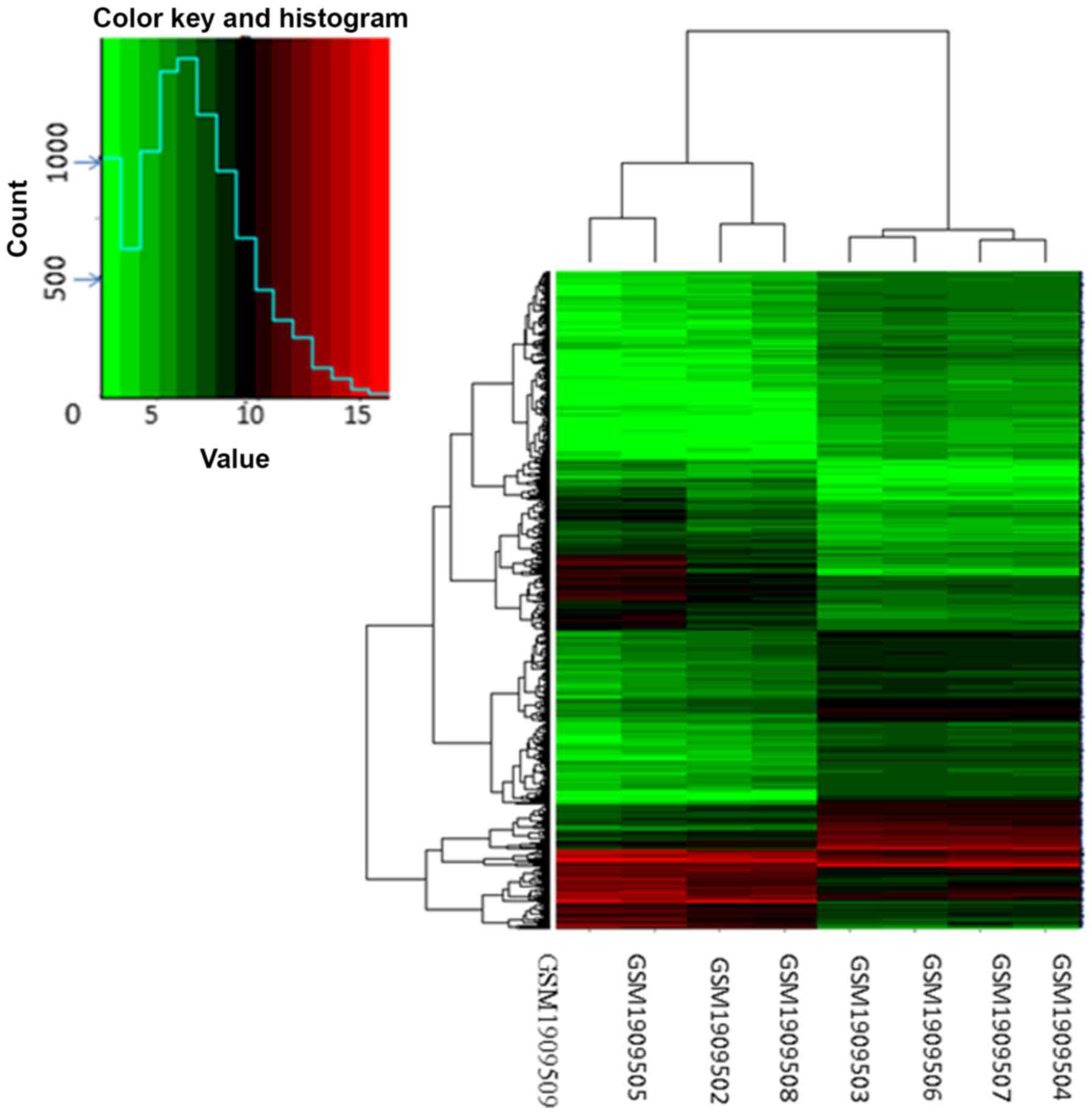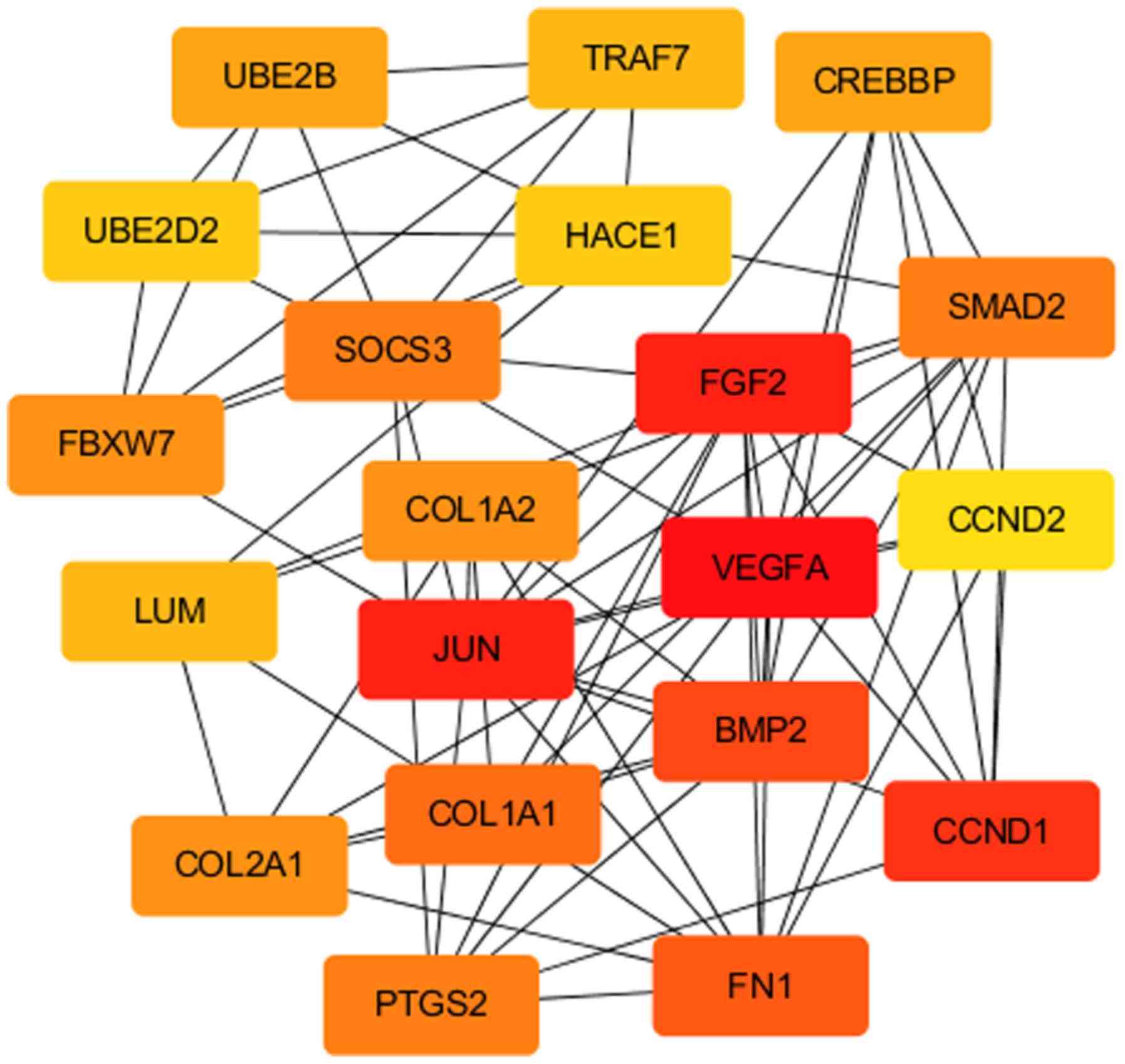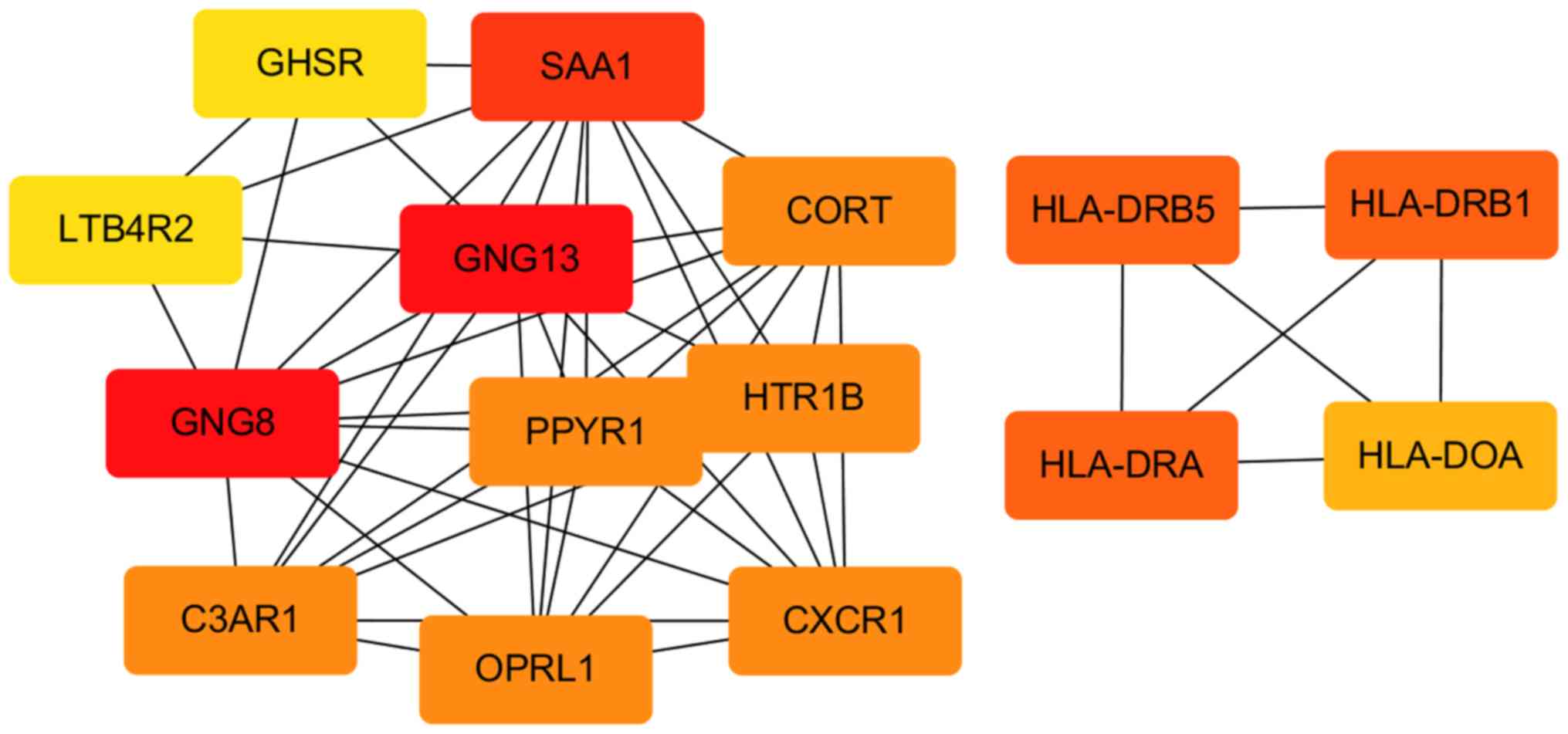|
1
|
Zhang QY, Li ZR, Gao FQ and Sun W:
Pericollapse stage of osteonecrosis of the femoral Head: A last
chance for joint preservation. Chin Med J (Engl). 131:2589–2598.
2018. View Article : Google Scholar : PubMed/NCBI
|
|
2
|
Hauzeur JP, Malaise M and de Maertelaer V:
A prospective cohort study of the clinical presentation of
non-traumatic osteonecrosis of the femoral head: Spine and knee
symptoms as clinical presentation of hip osteonecrosis. Int Orthop.
40:1347–1351. 2016. View Article : Google Scholar : PubMed/NCBI
|
|
3
|
Moya-Angeler J, Gianakos AL, Villa JC, Ni
A and Lane JM: Current concepts on osteonecrosis of the femoral
head. World J Orthop. 6:590–601. 2015. View Article : Google Scholar : PubMed/NCBI
|
|
4
|
Shah KN, Racine J, Jones LC and Aaron RK:
Pathophysiology and risk factors for osteonecrosis. Curr Rev
Musculoskelet Med. 8:201–209. 2015. View Article : Google Scholar : PubMed/NCBI
|
|
5
|
Al-Khateeb H, Kwok IH, Hanna SA, Sewell MD
and Hashemi-Nejad A: Custom cementless THA in patients with
legg-calve-perthes disease. J Arthroplasty. 29:792–796. 2014.
View Article : Google Scholar : PubMed/NCBI
|
|
6
|
Huang G, Zhao G, Xia J, Wei Y, Chen F,
Chen J and Shi J: FGF2 and FAM201A affect the development of
osteonecrosis of the femoral head after femoral neck fracture.
Gene. 652:39–47. 2018. View Article : Google Scholar : PubMed/NCBI
|
|
7
|
Xu X, Wen H, Hu Y, Yu H, Zhang Y, Chen C
and Pan X: STAT1-caspase 3 pathway in the apoptotic process
associated with steroid-induced necrosis of the femoral head. J Mol
Histol. 45:473–485. 2014. View Article : Google Scholar : PubMed/NCBI
|
|
8
|
Tian L, Wen Q, Dang X, You W, Fan L and
Wang K: Immune response associated with Toll-like receptor 4
signaling pathway leads to steroid-induced femoral head
osteonecrosis. BMC Musculoskelet Disord. 15:182014. View Article : Google Scholar : PubMed/NCBI
|
|
9
|
Li P, Zhai P, Ye Z, Deng P, Fan Y, Zeng Y,
Pang Z, Zeng J, Li J and Feng W: Differential expression of
miR-195-5p in collapse of steroid-induced osteonecrosis of the
femoral head. Oncotarget. 8:42638–42647. 2017.PubMed/NCBI
|
|
10
|
Wei B, Wei W, Zhao B, Guo X and Liu S:
Long non-coding RNA HOTAIR inhibits miR-17-5p to regulate
osteogenic differentiation and proliferation in non-traumatic
osteonecrosis of femoral head. PLoS One. 12:e01690972017.
View Article : Google Scholar : PubMed/NCBI
|
|
11
|
Ma XL, Liu ZP, Ma JX, Han C and Zang JC:
Dynamic expression of Runx2, Osterix and AJ18 in the femoral head
of steroid-induced osteonecrosis in rats. Orthop Surg. 2:278–284.
2010. View Article : Google Scholar : PubMed/NCBI
|
|
12
|
Lin Z and Lin Y: Identification of
potential crucial genes associated with steroid-induced necrosis of
femoral head based on gene expression profile. Gene. 627:322–326.
2017. View Article : Google Scholar : PubMed/NCBI
|
|
13
|
Tong P, Wu C, Jin H, Mao Q, Yu N, Holz JD,
Shan L, Liu H and Xiao L: Gene expression profile of
steroid-induced necrosis of femoral head of rats. Calcif Tissue
Int. 89:271–284. 2011. View Article : Google Scholar : PubMed/NCBI
|
|
14
|
Liu R, Liu Q, Wang K, Dang X and Zhang F:
Comparative analysis of gene expression profiles in normal hip
human cartilage and cartilage from patients with necrosis of the
femoral head. Arthritis Res Ther. 18:982016. View Article : Google Scholar : PubMed/NCBI
|
|
15
|
Barrett T, Wilhite SE, Ledoux P,
Evangelista C, Kim IF, Tomashevsky M, Marshall KA, Phillippy KH,
Sherman PM, Holko M, et al: NCBI GEO: archive for functional
genomics data sets-update. Nucleic Acids Res. 41:D991–D995. 2013.
View Article : Google Scholar : PubMed/NCBI
|
|
16
|
Ritchie ME, Phipson B, Wu D, Hu Y, Law CW,
Shi W and Smyth GK: limma powers differential expression analyses
for RNA-sequencing and microarray studies. Nucleic Acids Res.
43:e472015. View Article : Google Scholar : PubMed/NCBI
|
|
17
|
Huang da W, Sherman BT and Lempicki RA:
Systematic and integrative analysis of large gene lists using DAVID
bioinformatics resources. Nat Protoc. 4:44–57. 2009. View Article : Google Scholar : PubMed/NCBI
|
|
18
|
Huang da W, Sherman BT and Lempicki RA:
Bioinformatics enrichment tools: Paths toward the comprehensive
functional analysis of large gene lists. Nucleic Acids Res.
37:1–13. 2009. View Article : Google Scholar : PubMed/NCBI
|
|
19
|
Kanehisa M, Sato Y, Furumichi M, Morishima
K and Tanabe M: New approach for understanding genome variations in
KEGG. Nucleic Acids Res. 47:D590–D595. 2019. View Article : Google Scholar : PubMed/NCBI
|
|
20
|
Kanehisa M, Furumichi M, Tanabe M, Sato Y
and Morishima K: KEGG: New perspectives on genomes, pathways,
diseases and drugs. Nucleic Acids Res. 45:D353–D361. 2017.
View Article : Google Scholar : PubMed/NCBI
|
|
21
|
Kanehisa M and Goto S: KEGG: Kyoto
encyclopedia of genes and genomes. Nucleic Acids Res. 28:27–30.
2000. View Article : Google Scholar : PubMed/NCBI
|
|
22
|
Szklarczyk D, Franceschini A, Wyder S,
Forslund K, Heller D, Huerta-Cepas J, Simonovic M, Roth A, Santos
A, Tsafou KP, et al: STRING v10: Protein-protein interaction
networks, integrated over the tree of life. Nucleic Acids Res.
43:D447–D452. 2015. View Article : Google Scholar : PubMed/NCBI
|
|
23
|
Jensen LJ, Kuhn M, Stark M, Chaffron S,
Creevey C, Muller J, Doerks T, Julien P, Roth A, Simonovic M, et
al: STRING 8-a global view on proteins and their functional
interactions in 630 organisms. Nucleic Acids Res. 37:D412–D416.
2009. View Article : Google Scholar : PubMed/NCBI
|
|
24
|
Shannon P, Markiel A, Ozier O, Baliga NS,
Wang JT, Ramage D, Amin N, Schwikowski B and Ideker T: Cytoscape: A
software environment for integrated models of biomolecular
interaction networks. Genome Res. 13:2498–2504. 2003. View Article : Google Scholar : PubMed/NCBI
|
|
25
|
Bertolazzi P, Bock ME and Guerra C: On the
functional and structural characterization of hubs in
protein-protein interaction networks. Biotechnol Adv. 31:274–286.
2013. View Article : Google Scholar : PubMed/NCBI
|
|
26
|
Li Z, Yang B, Weng X, Tse G, Chan MTV and
Wu WKK: Emerging roles of MicroRNAs in osteonecrosis of the femoral
head. Cell Prolif. 51:2018. View Article : Google Scholar :
|
|
27
|
Cohen-Rosenblum A and Cui Q: Osteonecrosis
of the femoral Head. Orthop Clin North Am. 50:139–149. 2019.
View Article : Google Scholar : PubMed/NCBI
|
|
28
|
Wei B and Wei W: Identification of
aberrantly expressed of serum microRNAs in patients with
hormone-induced non-traumatic osteonecrosis of the femoral head.
Biomed Pharmacother. 75:191–195. 2015. View Article : Google Scholar : PubMed/NCBI
|
|
29
|
Song Y, Du ZW, Yang QW, Ren M, Wang QY,
Wang A, Chen GY, Zhao HY, Yu T and Zhang GZ: Association of genes
variants in RANKL/RANK/OPG signaling pathway with the development
of osteonecrosis of the femoral head in Chinese population. Int J
Med Sci. 14:690–697. 2017. View Article : Google Scholar : PubMed/NCBI
|
|
30
|
Peng X and Guan JL: Focal adhesion kinase:
From in vitro studies to functional analyses in vivo. Curr Protein
Pept Sci. 12:52–67. 2011. View Article : Google Scholar : PubMed/NCBI
|
|
31
|
Zhang Y, Ma C, Yu Y, Liu M and Yi C: Are
CXCL13/CXCR5/FAK critical regulators of MSCs migration and
differentiation? Med Hypotheses. 84:213–215. 2015. View Article : Google Scholar : PubMed/NCBI
|
|
32
|
MacDonald RJ and Yen A: CXCR5
overexpression in HL-60 cells enhances chemotaxis toward CXCL13
without anticipated interaction partners or enhanced MAPK
signaling. In Vitro Cell Dev Biol Anim. 54:725–735. 2018.
View Article : Google Scholar : PubMed/NCBI
|
|
33
|
Gu YX, Du J, Si MS, Mo JJ, Qiao SC and Lai
HC: The roles of PI3K/Akt signaling pathway in regulating MC3T3-E1
preosteoblast proliferation and differentiation on SLA and SLActive
titanium surfaces. J Biomed Mater Res A. 101:748–754. 2013.
View Article : Google Scholar : PubMed/NCBI
|
|
34
|
Xue XH, Feng ZH, Li ZX and Pan XY:
Salidroside inhibits steroid-induced avascular necrosis of the
femoral head via the PI3K/Akt signaling pathway: In vitro
and in vivo studies. Mol Med Rep. 17:3751–3757.
2018.PubMed/NCBI
|
|
35
|
Wu X, Zheng S, Ye Y, Wu Y, Lin K and Su J:
Enhanced osteogenic differentiation and bone regeneration of
poly(lactic-co-glycolic acid) by graphene via activation of
PI3K/Akt/GSK-3β/β-catenin signal circuit. Biomater Sci.
6:1147–1158. 2018. View Article : Google Scholar : PubMed/NCBI
|
|
36
|
Aki T, Hashimoto K, Ogasawara M and Itoi
E: A whole-genome transcriptome analysis of articular chondrocytes
in secondary osteoarthritis of the hip. PLoS One. 13:e01997342018.
View Article : Google Scholar : PubMed/NCBI
|
|
37
|
Zhang C, Ma J, Li M, Li XH, Dang XQ and
Wang KZ: Repair effect of coexpression of the hVEGF and hBMP genes
via an adeno-associated virus vector in a rabbit model of early
steroid-induced avascular necrosis of the femoral head. Transl Res.
166:269–280. 2015. View Article : Google Scholar : PubMed/NCBI
|
|
38
|
Hang D, Wang Q, Guo C, Chen Z and Yan Z:
Treatment of osteonecrosis of the femoral head with VEGF165
transgenic bone marrow mesenchymal stem cells in mongrel dogs.
Cells Tissues Organs. 195:495–506. 2012. View Article : Google Scholar : PubMed/NCBI
|
|
39
|
Peng WX and Wang L: Adenovirus-mediated
expression of BMP-2 and BFGF in bone marrow mesenchymal stem cells
combined with demineralized bone matrix for repair of femoral head
osteonecrosis in beagle dogs. Cell Physiol Biochem. 43:1648–1662.
2017. View Article : Google Scholar : PubMed/NCBI
|
|
40
|
Xu J and Lin DI: Oncogenic c-terminal
cyclin D1 (CCND1) mutations are enriched in endometrioid
endometrial adenocarcinomas. PLoS One. 13:e01996882018. View Article : Google Scholar : PubMed/NCBI
|
|
41
|
Wu J, Cui LL, Yuan J, Wang Y and Song S:
Clinical significance of the phosphorylation of MAPK and protein
expression of cyclin D1 in human osteosarcoma tissues. Mol Med Rep.
15:2303–2307. 2017. View Article : Google Scholar : PubMed/NCBI
|
|
42
|
Blake BL, Wing MR, Zhou JY, Lei Q,
Hillmann JR, Behe CI, Morris RA, Harden TK, Bayliss DA, Miller RJ
and Siderovski DP: G beta association and effector interaction
selectivities of the divergent G gamma subunit G gamma(13). J Biol
Chem. 276:49267–49274. 2001. View Article : Google Scholar : PubMed/NCBI
|
|
43
|
da Silva Junior IA, de Sousa Andrade LN,
Jancar S and Chammas R: Platelet activating factor receptor
antagonists improve the efficacy of experimental chemo- and
radiotherapy. Clinics (Sao Paulo). 73 (Suppl 1):e792s2018.
View Article : Google Scholar : PubMed/NCBI
|
|
44
|
Filgueiras LR, Koga MM, Quaresma PG,
Ishizuka EK, Montes MB, Prada PO, Saad MJ, Jancar S and Rios FJ:
PAFR in adipose tissue macrophages is associated with
anti-inflammatory phenotype and metabolic homoeostasis. Clin Sci
(Lond). 130:601–612. 2016. View Article : Google Scholar : PubMed/NCBI
|
|
45
|
Chen J, Lan T, Zhang W, Dong L, Kang N,
Zhang S, Fu M, Liu B, Liu K, Zhang C, et al: Platelet-activating
factor receptor-mediated PI3K/AKT activation contributes to the
malignant development of esophageal squamous cell carcinoma.
Oncogene. 34:5114–5127. 2015. View Article : Google Scholar : PubMed/NCBI
|












